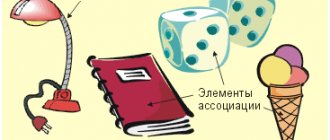You may already have become familiar with one interesting technique for memorizing information to successfully prepare for a session. But we decided not to stop there and introduce you to at least four more effective methods for quickly memorizing text or any other information. Read, think, choose the one that suits you.
All of the following techniques are based on repeated reading. But we are not talking about haphazard and thoughtless reading, but about deep work on the text.
Method No. 1. Method of analogy or association.
Any innovation that is difficult to learn can be learned through association. To do this, it is enough to draw a parallel with some familiar phenomenon or event. Moreover, the established analogy may have nothing to do with the phenomenon being studied. It should be simple, close and understandable directly to the student: an event from his life, a favorite word, etc.
Application of the analogy method in practice
Experienced experts recommend drawing analogies with similar words that are consonant with the term or topic being studied. This technique can speed up the “learning process” by 40-50%, while memorizing information is guaranteed.
This technique is most often followed by people with good imagination, a bright and rich life, who have something to “compare” with a term, object, etc.
Conditions for effective memorization
To manage your memorization process and achieve good results, apply the following principles:
- do not let this process take its course, use conscious memorization;
- strengthen your memory with special exercises - we have compiled a selection of them in a separate article;
- give up cramming in favor of mnemonics coupled with analytical memorization. For example, first learn all the terms, formulas and definitions of a paragraph through images, and then analyze the text, make a mind map based on it and memorize it again using mnemonics.
- remember that the state of memory is closely related to our general physical condition: a balanced diet, adequate sleep, the absence of stress and bad habits increases the ability to remember even without the use of special techniques.
Method No. 2. Abbreviation.
An abbreviation is a shortening of words. Today, each of us is faced with various abbreviations every day: IMF, Central Bank of the Russian Federation, CIS, etc. Even schoolchildren, when writing down homework, essentially use abbreviations and the principle of “verbal minimalism” (for example, Russian language exercise 360).
An abbreviation can be presented in different forms: an abbreviation based on the first letters of a word, a saying, where each first or last letter indicates a specific feature (for example, the color of the rainbow), etc.
Using abbreviations to better remember information
Similarly, a student can study subjects. Most often, he uses abbreviations when taking notes on lectures (this is where new abbreviations are born), but why not start learning the subject with the help of them?
Read the topic and then create an “abbreviated version” of it. It is important to note that this technique will allow you not only to better remember the most important things, but also to prepare cheat sheets that will help you out in difficult times or will warm your soul, calming you down during the exam.
Any difficulties?
Need teacher help?
We are always happy to help you!
master's theses
Content
- How neural connections are formed
- Remember everything: general recommendations
- Memory techniques
Throughout life, the human brain creates more and more neural connections that a person needs in vital processes:
- production and understanding of speech,
- control over your own body movements,
- formation and strengthening of memory.
When these connections are destroyed, some areas of the brain stop communicating with each other. This makes it more difficult for a person to remember new information.
In this article, you will learn how to approach the study of this or that material correctly in order to forever retain everything you have learned in your memory.
Method No. 3. We remember visually.
If you have a well-developed visual memory, then try not just to memorize the material, but to remember its location in a textbook, lecture or other primary source. This will not only allow you, if necessary, to quickly find a fragment for a full answer, or copy it off during a test or exam. It is enough to remember on what page it was written, what this page looks like (a crushed corner, old, shabby paper), in which paragraph the information suitable for an answer is located, and how the text will completely appear before your eyes.
Exercises for memory development
Schulte tables
The tables, developed by German psychiatrist Walter Schulte, contain randomly placed objects. Exercises can improve not only visual memory, but also peripheral vision, which is important for speed reading. Tables can have different sizes - you can start with 2x2. Look at the table for 5 minutes and then try to reproduce the contents of the cells.
You can train on a special website or mobile application.
Aivazovsky method
The artist used this method in order to be more attentive to the world around him and reproduce significant details in his paintings. The technique is simple: select any landscape, interior, look at it for 5 minutes and reproduce it on paper. Gradually reduce the time period.
Rewind
Every day before going to bed, scroll through your day and remember not only the sequence of events, but also reproduce the feelings that you had at one time or another. Try to remember the dialogues accurately or say new information.
Another way to rewind is to count backwards, choosing only even or odd numbers. Or name numbers that are divisible by three.
Building associations
Write any words randomly and divide them into three columns. Your task is to remember them for a minute and then write them down on a blank sheet of paper. The task is not to memorize, but to build associations and relationships between words that at first glance may seem unrelated.
Memorization while multitasking
In fact, a person cannot perform several tasks at the same time, but he is able to quickly switch attention from one subject to another. Choose a poem to learn and ask your friends to ask you a variety of questions and challenges for two minutes. For example, describe a child’s favorite sweet or solve an example. This training, thanks to constant resistance, will increase your attention aimed at memorizing the poem. You may not succeed the first time, but over time you will remember more and more.
Method No. 4. The method of arranging objects or the “Cicero” method.
If after reading you were unable to remember anything, do not freak out or despair. Try connecting memory and associations at the same time. Remember the environment or room that is familiar to you, imagine that you are in it. And now “put each moment you read into its place” in this room, but this must be done in the order in which you usually walk through the room (out of habit).
The principle of the Cicero method
Let's say you're standing in front of your own bedroom door. The door itself is a theme, you entered and put things on a chair or in a closet (there should be another link to the theme, an introductory note, for example, how it all began, etc.), then you go to the bed and sit down/lie down (here is another link) and etc. And so you need to learn and “rehearse” until you remember everything you need.
Further, if you suddenly forget something during the exam, you just need to remember the usual room and procedure, and your memory will give you the entire text.
What is the essence of our approach
Our center has been developing accelerated learning technologies for 11 years. During this time, our methodologists have created more than 50 courses in a variety of areas: from language to personal development programs.
But at the heart of each of them is the development of memory skills. Any of the courses, be it English or effective reading, pumps up your memory, teaches you how to use mnemonics and work with information. Graduates of our courses note pleasant side effects in the form of improved memory and attention. Being able to remember any information quickly and for a long time, you will learn with pleasure and results.
This is our approach, which we recommend that everyone follow: when starting any new project, always start with memory development. Good luck!
Method No. 5. Rhyming.
Memorizing poetry is much easier than boring and long text. Why not turn the study of the subject into one large poem with chapter themes? To do this, it is enough to rhyme each term or definition with familiar and everyday words or even rewrite them as poetry (of any composition).
If you are far from writing creative works or poetry, then you can simply link individual concepts to poems already familiar to you. To do this, you need to connect associations or analogies, a little imagination.
Use the Aivazovsky method
Using this method, which is attributed to the famous marine painter, you can connect photographic memory. She will come to the rescue when you need to remember in the smallest detail any view, picture or image of a loved one.
Look at an object, landscape or person for three to five seconds, trying to remember the details. Then close your eyes and mentally imagine the object in the smallest detail. Ask yourself questions about the details of this image and mentally answer. Then open your eyes for one second, look at the object again and complete the image. Squint your eyes and try to achieve the brightest possible image of the object. Repeat the last two steps several times.
Method No. 6. We encrypt the recording.
If complex terms are difficult to memorize and decipher, then it is worth trying to transform the process of preparing for a test or certification into a children's game - encryption. Remember how you used to correspond with your friends in a language that was incomprehensible to others: you assigned each letter a number or a specific symbol, etc. Why not apply this method here too? Scientists have proven that the form of play activates brain cells, and the feeling of excitement allows you to quickly understand the essence of the matter.
Features of using the encryption method
Students most often “encrypt” information “in their own way.” They look for analogies between numbers and letters, symbols and individual elements. For example, in mathematics there are certain abbreviations (for example, infinity, sum, etc.). Why not use familiar symbols in other objects?
Practice visualization
The technique will allow you to remember numbers and names well. To do this, you need to figuratively, in detail, imagine the information being remembered.
Example:
You need to remember the name. Imagine each of its letters: they are covered with ivy, some have flowers growing on them, and so on. How many letters are there in total? Recalculate. Which one is the first? What is the second one like, what does it look like? As a result, you will be able to break information down into components and remember each one. And when the brain receives a request on this topic, it will simply put together the puzzle.
Method No. 7. Spaced repetition.
Everyone knows that learned material can be “erased from memory” over time if it is not used. This is how the body cleanses itself of unnecessary and useless information, freeing up space for new discoveries and information. Therefore, if you want the learned material to be stored for as long as possible, and preparation for certification to be easy and quick: delve into each topic from the very beginning, and then periodically repeat what you have covered: re-read lectures, seminars, etc.
In this case, preparing for the exam will be easy and relaxed: the author will know everything necessary, he will only have to repeat it, focusing on the most difficult moments for him.
Moreover, experts note that it is necessary to repeat, not just re-reading the data at hand. It is important to try to extract them from memory, and rereading is intended to fill in the identified gaps. Therefore, first try to remember and tell the question, then re-read it and retell it again.
If the topic is too long, it is best to adhere to the following rules of spaced repetition:
- Review the material directly on the day you learn the topic;
- On the second or third day, retell what you taught, re-read the question again and highlight the key points;
- After 5-6 days, repeat what you have learned again, if necessary, read it again.
To better understand the material, it is enough to devote 10-15 minutes to it every day: briefly retelling and quickly rereading lectures or other manuals.
Using an accumulation system: Atkinson's method
But Atkinson is confident that memory should improve gradually, without sudden jumps and overloads. Therefore, the only safe and proven method of strengthening memory is the accumulation method.
The scientist proposes to leave aside all artificial techniques, using only what nature itself has given us. The brain, like all muscles, needs training and gradual loads. As loads increase, memory efficiency will also increase.
This system was actively used in ancient times, when only a select few knew how to use a pen, and wise men could not always trust their secrets
The essence of the system is this:
- Choose a text (optimally in poetic form). On the first day, 4 to 6 lines are learned by heart.
- On the second day, they repeat yesterday’s learned lines and additionally learn 4 to 6 more lines.
- On the third day, 4-6 new lines are added to those already learned.
The greater the number of repetitions, the better the new material is remembered.
It's okay if you peek at the book from time to time. Don’t be upset if you forget something: over time, your memory will increase and memorization will become easier.
After a month, double the amount of information you master. In another month, you can triple the amount of information.
Research has shown that as a result of using this technique:
- learned knowledge remains for a long time and easily emerges in memory,
- the ability to remember absolutely any thing improves all the time,
- With the help of willpower, any information is easily remembered.
The essence of this method is nothing other than repetition. It is better to conduct classes in the morning, since at this time of day our perception is still fresh. Train every day and you will see: within a month your brain will begin to remember many times more information.
Method No. 8. Edge principle.
What information does a person remember most quickly? As a rule, when studying a topic, the initial and final scenes are engraved in the memory, and the middle remains “unconscious”.
If you read the material, but could not completely remember it, do not be discouraged. We are more than sure that the first and last couple of paragraphs remained in our memory. To remember the rest, you need to start learning from those moments that could not be memorized. Just start studying precisely from those fragments that you failed to learn or did not understand.
Types of memory by sensory modality
Depending on which channel is leading in the perception of information, memory is divided into auditory, visual, gustatory, olfactory and tactile
(memory in sensations).
For example, smelling the perfume your first teacher wore can unexpectedly revive a chain of childhood memories. This is the result of the work of olfactory memory. And if you remember the New Year when you eat tangerines, it means the taste has worked.
With rare exceptions, the visual channel is the leading one. But this does not mean that everything else can be abolished. They are good to use as auxiliary ones.
For example, in order to better remember hieroglyphs, you can not only assign similar images to them (mnemonics), but also “draw” features in the air with wide movements of the hand or even the legs and head. This way you use tactile memory - body memory.
Method No. 9. Let's get to the point.
Believe me, if you tell a question or topic in your own words, without intricate and florid book phrases or clichés, then this knowledge will be much more valuable, both for you and for the teacher, who will make sure that the student has understood all the nuances and understands the material , learned it.
Identification of the most significant in the total amount of information
Therefore, when studying any subject or issue, highlight the essence (key aspects of terms, theories, formulas) and learn it. As popular wisdom says, the rest will follow.
How to develop memory
In many ways, memory development is associated with training attention and improving the ability to concentrate. These processes are interconnected, since the more a person keeps his attention on something, the more he is able to remember.
The effectiveness of memorization depends on:
- motivation, desire to remember this information
- significance, which is directly related to practicality
- emotional perception
- depth of immersion in material
- number of repetitions
- psychophysical state
- combining different memorization techniques
Method No. 10. Feynman's method.
This principle was named after its creator, a theoretical physicist named Richard Feynman, who managed to develop a unique method for storing information. His “law” is based on simplifying complex issues by using simple and understandable words, phrases and phrases.
This rule is implemented in three stages:
- We write out abstracts or create a plan of material that will allow you to briefly and succinctly describe the essence, highlight basic concepts, etc.;
- As the plan is formed, we re-read the material and identify gaps that were not covered in detail in the previous paragraph. It is important to use only simple and understandable words for you;
- Next, we form a simple and understandable full-fledged text, which will describe all the main aspects of the topic being studied. All that remains is to read and retell it, repeating it periodically to reinforce it.
What is mnemonics?
Mnemonics or mnemonics
- These are specially developed techniques and methods that make it easier to memorize certain types of information. In some textbooks and courses, authors use the term “mnemonics” to denote the entire set of techniques and methods for memorizing information used for certain data, and the term “mnemonics” is interpreted as the practical application of methods defined for a given specific mnemonics.
The main principle of any mnemonics is the replacement of abstract objects with concepts that have a visual, auditory or, less often, other sensory representation, linking objects with existing information (building associations) to simplify its memorization.
Recommendations from Dishelp experts on how to assimilate the material as efficiently as possible
When studying and memorizing a large amount of information, it is important to create decent conditions: silence, peace, a minimum of distractions over trifles, allocate separate time for studying the subject, etc. Therefore, turn off all gadgets, warn your family or “roommates” so as not to be disturbed, concentrate in preparation.
Tips for better assimilation and memory of new information
Include all methods of memorizing information that are acceptable to you. Actively use those techniques that correspond to the “type of your memory”: visual, auditory (audio), written. If it’s easier for you to remember by ear, listen to audio books; in writing, take notes on all the questions; visually, use the association method, remember the location of the text in the original source, etc.
Don't give up on repetition. It is this that can not only refresh, but also deepen a student’s knowledge. It is enough to devote 10-15 minutes to each subject for repetition. At the same time, do not forget to take a short break when studying new topics, give your body time to recuperate.
Reading aloud and mental repetition: the OCHOG method
This method of quickly memorizing information is similar to the previous one, but it also has its differences.
An experiment was conducted at Kazan University, during which the subjects formed 4 groups. The task for everyone is to remember the text. In the first group, the text was read aloud 4 times. In the second, the text was read aloud 3 times and mentally retold once by the students. In the third, the text was read twice and retold twice mentally. In the fourth, the text was read aloud only once, and mentally retold 3 times by the listeners.
The results showed the greatest memorization efficiency among students of the fourth group. Students of the third group remembered information a little less effectively, students of the second group remembered the information worse than the others.
Thanks to this experiment, the OCHOG method appeared:
- Orientation . When reading a text, it is important to understand its main idea. If necessary, write it down or underline it, repeating it in memory many times.
- Reading . When reading again, the information is read more carefully, smaller details are highlighted, and a connection is established between them and the main ideas of the text. The main thoughts attached to details are repeated mentally several times.
- Review . A quick review of the text determines whether the main ideas and their connection to the details have been correctly identified. For a deeper understanding, you can ask questions to the main parts.
- Main . A mental retelling is performed, and, if possible, out loud. At this stage, it is important to remember the main thoughts and answer the questions posed.
Try to keep the number of readings to a minimum. In this case, the number of mental repetitions can be absolutely any necessary for better assimilation in memory.
Using associations when remembering
To make memorization easier, you need to group words by content, or words with a common root, or words that are similar in sound composition. It is advisable to compare a new word with a known one, find similarities and differences between them. You can also establish external associations: remember what letter the word begins with, what syllable it ends with, where it is printed in a book or dictionary.
Develop associative thinking by coming up with various associations for any pairs of words.
Leitner's system: 5 steps to learn anything
How often do you have to complain about your memory? How often do you need to remember something, but you just can’t remember it? And how quickly do you get so tired of repeating all this that you decide to do without this knowledge? About 80% of people who study, for example, a foreign language face a similar situation. And just to help them, the Leitner system was created, the main one of which is the so-called flash cards, on which information is recorded for memorization. However, it later turned out that the system is suitable for memorizing any information, not just linguistic information. What kind of system is this? We invite you to get acquainted in this article. Read more…
6
System for memorizing numbers and cards - ChDP
We live in the 21st century, in the era of information technology. And we happily transfer many of our problems to machines. One of these problems is the need to remember information. Indeed, why do we need to remember our to-do list, groceries or any large amounts of data if all this is just a few clicks away? Despite this, many people try to improve their memory. This is convenient in everyday life and very useful: by forcing your brain to work in your youth, you will thank yourself in old age. In this article we will introduce you to a special system for memorizing numbers and cards called “Person - Action - Object” (PA). Read more…
4
Remembering related text
To successfully memorize related material, semantic “memory knots” are used. These are key words that will help reproduce the meaning of the selected passage. You can write them down, then try to reproduce the memorized text from them, then compare it with the original source and identify your mistakes, not forgetting to make your own comments. Then, having removed the written key words, try to remember them and reproduce the text from memory. By practicing in this way, you can achieve involuntary memorization of the text.
Word memorization training
Memorizing words should begin with simpler exercises from words denoting objects to words denoting concepts.
If at the beginning of training the interval between memorized words is 15 - 20 seconds, you should then reduce it to 2 - 3 seconds, increasing the number of memorized words from 10 to 100, practicing daily for 60 - 90 minutes. In this case, you should create bright, unusual figurative associations. In a month, you will easily remember any words in large quantities.











